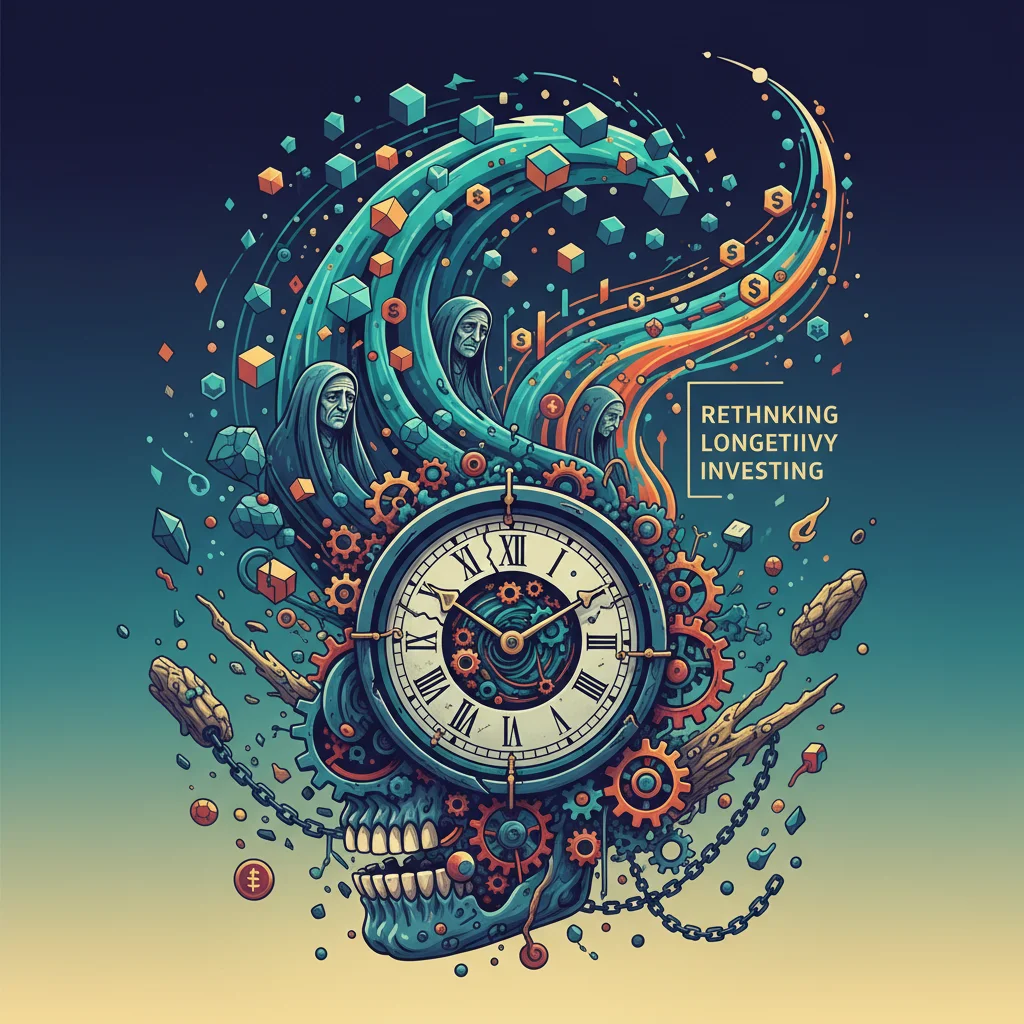
The Struldbrug’s Curse: Why the Finance World Must Rethink Longevity Investing
In Jonathan Swift’s 18th-century masterpiece, Gulliver’s Travels, the intrepid explorer Lemuel Gulliver encounters a peculiar and tragic race of people known as the Struldbrugs. Born with a mark on their forehead, they are destined for immortality. At first, Gulliver is enchanted, imagining an eternity of accumulated wisdom and experience. But he soon discovers the horrifying reality: the Struldbrugs are granted eternal life, but not eternal youth. They suffer the endless indignities of aging—physical decay, dementia, and profound despair. Legally declared dead at eighty, they become outcasts, a grim reminder of a gift turned into an unbearable curse.
This powerful literary allegory, highlighted in a letter to the Financial Times, serves as a crucial cautionary tale for the modern world. Today, humanity is on its own quest for immortality, fueled by billions of dollars pouring into the longevity industry. We are obsessed with extending lifespan. But as we stand on the precipice of breakthroughs in biotechnology and medicine, we must ask ourselves a critical question: are we chasing a longer life, or a better one? For investors, business leaders, and financial professionals, the distinction between “lifespan” and “healthspan” is not merely semantic—it is the defining factor that will separate catastrophic risk from generational opportunity in the coming decades.
The Modern Gold Rush: Investing in a Longer Life
The pursuit of longevity is no longer the realm of science fiction. It’s a booming sector of the global economy. The global longevity and anti-senescence therapy market is projected to reach over $44 billion by 2030, attracting capital from Silicon Valley titans and institutional investors alike. High-profile ventures like Jeff Bezos’s Altos Labs and Google’s Calico Labs are dedicated to “reprogramming” biology to combat aging. This influx of capital is accelerating research in genomics, regenerative medicine, and cellular therapies, making the dream of a 100-plus-year life seem increasingly plausible.
From an investment perspective, the appeal is obvious. A breakthrough that adds even a few healthy years to human life would create markets of unimaginable scale, disrupting everything from healthcare and insurance to consumer goods and leisure. The potential for exponential returns has sent a jolt through the stock market, with biotech and health-tech stocks becoming portfolio staples for forward-thinking investors. However, this bullish outlook often overlooks the dark side of the equation—the Struldbrug scenario.
The €13.5 Billion Question: Why a Court Ruling on a Sicilian Bridge Matters to Global Investors
Gulliver’s Warning: The Economic Perils of Unhealthy Longevity
An economy where the average lifespan is 100, but the average healthspan (the period of life spent in good health) remains stuck at 65, is a recipe for economic collapse. This scenario, a real-world echo of the Struldbrugs’ fate, presents a multi-trillion-dollar liability that could cripple national economies and destabilize the global financial system.
The primary threats include:
- Unsustainable Healthcare Costs: Chronic age-related diseases are already the biggest driver of healthcare spending. The World Health Organization notes that population aging is poised to become one of the most significant social transformations of the twenty-first century (source). Extending life without compressing morbidity would mean decades of managing costly conditions like Alzheimer’s, heart disease, and diabetes, placing an impossible burden on public and private healthcare systems.
- Pension and Social Security Crises: Most modern pension systems, both public and corporate, are built on demographic models that are already outdated. Adding 10-20 years of post-retirement life without a corresponding increase in productive working years would render them insolvent. The math simply doesn’t work.
- Shrinking Productivity and a Stagnant Economy: A society with a large and growing population of frail, dependent elderly supported by a shrinking base of younger workers faces a demographic death spiral. Economic dynamism would grind to a halt as resources are diverted from innovation and investment towards eldercare and subsistence.
To put this in perspective, consider the potential divergence in economic outcomes. The table below illustrates the starkly different financial implications of focusing on lifespan versus healthspan extension.
| Economic Factor | Scenario 1: Lifespan Extension (The Struldbrug Model) | Scenario 2: Healthspan Extension (The Vitality Model) |
|---|---|---|
| Healthcare Spending | Exponential growth, focused on chronic disease management for 30+ years per person. | Growth is controlled, with a focus on preventative care and regeneration. Morbidity is compressed into a shorter period at the end of life. |
| Labor Force Participation | Sharp decline as people live longer but are too unwell to work, increasing dependency ratios. | Extended, flexible careers become the norm. “Retirement” is redefined as people remain productive and engaged into their 70s and 80s. |
| Pension System Viability | Insolvent. Payout periods far exceed contribution periods, leading to systemic failure or drastic benefit cuts. | Sustainable. Longer contribution periods and new financial products (e.g., phased retirement) align assets with liabilities. |
| GDP Growth & Innovation | Stagnant or negative. Capital is diverted to maintenance care, away from R&D, infrastructure, and new ventures. | Robust. Experienced, healthy older individuals contribute to the economy through work, entrepreneurship, and consumption. |
The Healthspan Revolution: A Smarter Financial Thesis
The true opportunity lies not in fighting death, but in preserving vitality. This is the healthspan revolution, and it represents a paradigm shift in medicine, economics, and investing. The goal is to ensure that as we live longer, we also stay healthier, more active, and more engaged. This pivot transforms longevity from a liability into a massive economic asset.
The investment landscape of the healthspan economy is diverse and rich with potential:
- Preventative and Predictive Medicine: Technologies like AI-driven diagnostics, genetic screening, and liquid biopsies can identify and address health risks before they become chronic, costly diseases. This is a cornerstone of financial technology in healthcare, optimizing resource allocation.
- Regenerative and Cellular Therapies: Instead of just managing decline, these fields aim to repair and rejuvenate the body at a cellular level, potentially reversing age-related damage and restoring function.
- Fintech for a New Lifecycle: The traditional “learn-earn-retire” model is obsolete. A 100-year healthspan requires new financial instruments. The banking and insurance industries will need to innovate with products like longevity insurance, flexible retirement accounts, and financial planning tools designed for multi-stage careers. Blockchain technology could play a role in securing lifelong health records or executing complex, long-term financial contracts.
- The “Active Aging” Market: A healthy, older population represents a powerful consumer demographic, driving demand for everything from adaptive technologies and lifelong education platforms to specialized travel and wellness services.
A Tale of Two Titans: Why Wall Street Cheered Google's AI Strategy and Jeered Meta's
Redefining the Financial Lifecycle for a 100-Year Life
The economic implications of a longer healthspan demand a complete overhaul of our understanding of personal finance and career trajectories. The concept of a hard stop “retirement” at 65 will become an anachronism. Instead, we will see a more fluid, multi-stage life.
This new model requires a fundamental shift in how we approach trading our time for money and how we invest for the future. The table below contrasts the old model with the emerging paradigm.
| Life Stage Aspect | Traditional 20th Century Model (Lifespan ~75) | Emerging Healthspan Model (Lifespan ~100+) |
|---|---|---|
| Education | Concentrated in the first 20-25 years. | Lifelong learning with multiple periods of upskilling and reskilling. |
| Career | A single, linear 40-year career. | A 60+ year “portfolio” of careers, including part-time work, sabbaticals, and entrepreneurship. |
| Financial Planning | Accumulate for 20-25 years of retirement. | Dynamic planning for multiple phases of work and leisure; managing assets and income for 40+ years post-primary career. |
| Key Financial Goal | Build a retirement nest egg. | Build a sustainable capital base to fund a multi-stage life of productivity and purpose. |
For the financial industry, this is a call to action. The banking sector needs to rethink loan structures for individuals starting new businesses at 60. The asset management world needs to develop investment strategies with 50-year horizons. The entire field of economics will have to adjust its models to account for a more experienced, and continuously productive, workforce.
The Billion-Pound Fright: Unpacking the Surprising Economics of Halloween
Conclusion: Heeding Gulliver’s Lesson
The tale of the Struldbrugs is a 300-year-old warning that has never been more relevant. As we pour capital and intellect into extending the human lifespan, we must ensure we are not inadvertently funding a future of widespread misery and economic decay. The blind pursuit of immortality is a fool’s errand; the intelligent pursuit of a longer, healthier life is the greatest economic and social opportunity of our time.
For investors, the message is clear: look beyond the sensational headlines of “curing death.” The most durable, world-changing returns will be found in the companies and technologies that are extending healthspan. For policymakers and business leaders, the challenge is to build the financial and social infrastructure—from flexible retirement plans to lifelong education systems—that can support a 100-year life of vitality and purpose. By focusing on the quality of our years, not just the quantity, we can ensure that the gift of a longer life is a blessing for the global economy, not a curse.


